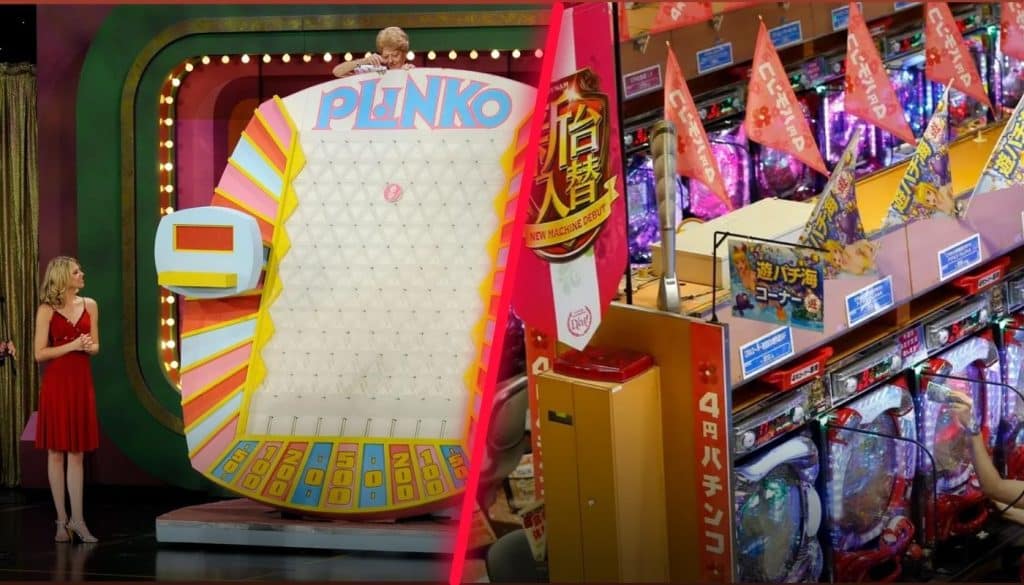Plinko and Pachinko are two popular games that are often compared due to their similarities in gameplay. Both games involve dropping the ball or puck into a board filled with obstacles and trying to land it in a specific spot to win prizes. However, there are also significant differences between the two games, including their origins, cultural significance, and gameplay mechanics. In this article, we will explore the similarities and differences between Plinko and Pachinko to help you understand these two exciting games better.
What is Plinko?
Plinko is a popular game of chance that has become a staple of many TV game shows. It was invented by Frank Wayne in 1983 and first appeared on the game show “The Price is Right.”
The game consists of a large board with a series of pegs arranged in a pattern. At the top of the board, there are a number of slots, each of which is worth a different prize. Players drop a small disk, or “Plinko chip,” from the top of the board and watch as it bounces randomly from peg to peg until it lands in one of the prize slots at the bottom.
The number and location of the pegs on the board determine the path that the chip takes as it falls. Unfortunately, players have no control over the direction of the chip, so the game is entirely based on chance.
The popularity of Plinko has grown over the years, and it has become a fixture on many TV game shows, including “The Price is Right,” “The Ellen DeGeneres Show,” and “The Late Late Show with James Corden.” Its simple yet entertaining gameplay has made it a favorite among viewers and contestants alike.
The Best Places to Play Plinko
What is Pachinko?
Pachinko is a popular gambling game in Japan that has been played for nearly a century. It was first invented in the 1920s as a children’s toy, but it quickly evolved into a popular form of adult entertainment.
Pachinko is played on a vertical machine that looks similar to a pinball machine. First, players buy metal balls, which they then launch into the machine using a spring-loaded lever. Next, the balls fall through a series of pins and obstacles on the machine, and players try to get as many balls as possible into designated pockets that will earn them more balls or prizes.
The game is entirely based on luck, and players have no control over where the balls will go once they are launched. However, skilled players can adjust the angle and force of their launch to try and increase their chances of success.
Pachinko is extremely popular in Japan, with estimates suggesting that there are over 10,000 Pachinko parlors across the country. As a result, it has become a significant part of Japanese culture, and many people view it as a form of entertainment and socializing rather than just gambling. However, the game has also been criticized for contributing to problem gambling and for its association with organized crime.
Comparison Between Plinko and Pachinko
Plinko and Pachinko are both games of chance that have gained popularity in different parts of the world. However, while they share some similarities, they also have some distinct differences.
Gameplay
The gameplay of Plinko and Pachinko is quite different. Plinko involves dropping a small disk down a board filled with pegs, while Pachinko involves launching metal balls into a vertical machine filled with obstacles. Both games are based on luck, and players have no control over the path that the disks or balls take.
Rules
The rules of Plinko are relatively simple, with players aiming to get their disk into one of the prize slots at the bottom of the board. Conversely, Pachinko has more complex rules, with players trying to get as many balls as possible into designated pockets that will earn them more balls or prizes.
Popularity
While Plinko is popular on TV game shows in the United States, it is not as widely played as Pachinko. Pachinko is extremely popular in Japan, with thousands of Pachinko parlors located across the country. In terms of global popularity, Pachinko is more popular than Plinko due to its popularity in Japan and the availability of Pachinko machines in other parts of the world.
Cultural Significance
Both games have some cultural significance in their respective countries. For example, Plinko is popular as a game show segment and has become a part of American pop culture. Conversely, Pachinko is deeply rooted in Japanese culture and has become a significant part of the entertainment industry.
Plinko and Pachinko are both games of chance with different gameplay and rules. While Plinko is more popular in the United States, Pachinko is more popular globally, particularly in Japan, where it has significant cultural significance.
Criticisms and Controversies
Both Plinko and Pachinko have faced criticism and controversy related to gambling addiction and its impact on society.
Plinko has been criticized for its association with gambling and its potential to promote addictive behavior. Some people argue that the game’s simple and exciting gameplay can create a rush that is similar to that experienced by gambling addicts, leading them to seek out other forms of gambling. Additionally, Plinko’s popularity on TV game shows can normalize gambling behavior and make it seem like a harmless pastime.
Pachinko has faced similar criticisms, particularly in Japan, where it is a popular form of gambling. The game’s addictive gameplay has led to concerns about problem gambling and its impact on individuals and families. There have also been controversies related to the Pachinko industry’s links to organized crime, as some Pachinko parlors are owned or controlled by yakuza gangs.
The impact of gambling addiction is significant, with individuals and families experiencing financial, emotional, and psychological harm. Additionally, the prevalence of gambling addiction can have broader societal impacts, including increased crime rates and decreased productivity.
Both Plinko and Pachinko have faced controversy related to their potential to contribute to gambling addiction and their impact on society. While they are both popular games that provide entertainment and enjoyment to many people, it is essential to be aware of the potential risks associated with gambling and to approach these games with caution.
FAQ
Are Plinko and Pachinko the same?
No, Plinko and Pachinko are not the same game. While they both involve dropping objects and are games of chance, they have different gameplay, rules, and cultural significance. Plinko is a popular game on TV shows in the United States, where players drop small disks down a board filled with pegs. On the other hand, Pachinko is a popular game in Japan, where players launch metal balls into a vertical machine filled with obstacles. While both games have faced criticisms related to gambling addiction, they have different histories and cultural contexts.
What game is Pachinko similar to?
Pachinko is a unique game that does not have a direct equivalent in Western culture. However, some have drawn comparisons between Pachinko and pinball, as both games involve launching objects and navigating obstacles. Additionally, the gameplay of Pachinko has been compared to slot machines, as both involve chance-based gameplay and the potential to win prizes or money. Despite these similarities, Pachinko has its own distinct history, gameplay, and cultural significance, making it a unique form of entertainment in its own right.
Why is Pachinko so popular?
A Pachinko is a popular form of entertainment in Japan for several reasons:
- Gambling: A Pachinko is a popular form of gambling in Japan, where gambling on most other sports and casino games is illegal. Pachinko is seen as a socially acceptable form of gambling, and it allows people to win prizes or money.
- Easy to Play: Pachinko is an easy game to learn and play. Players simply launch metal balls into a machine and hope to hit the jackpot. This simplicity makes it accessible to a wide range of players, including those who may not be familiar with other forms of gambling.
- Exciting Gameplay: Pachinko is an exciting game to play, with flashing lights, sounds, and music that create a lively and fun atmosphere. The unpredictability of the game also adds to the excitement, as players never know when they might hit the jackpot.
- Socializing: Pachinko parlors are often social spaces where people can gather with friends and family to play and have fun. In some cases, Pachinko parlors also offer food and drink, making them popular destinations for socializing.
- Cultural Significance: Pachinko has a deep cultural significance in Japan, where it has been a popular form of entertainment since the 1940s. The game is a significant part of Japan’s entertainment industry and has become a cultural icon.
Why is Plinko so popular?
Plinko is a popular game in the United States for several reasons:
- Familiarity: Plinko is a game that has been popularized on TV game shows such as “The Price is Right.” This familiarity with the game has helped to make it popular, as many viewers are familiar with the rules and gameplay.
- Easy to Play: Plinko is an easy game to learn and play. Players simply drop a small disk down a board filled with pegs, hoping to land on a prize slot at the bottom. This simplicity makes it accessible to many players.
- Exciting Gameplay: Plinko is an exciting game to play and watch, with the disks bouncing and bouncing off the pegs, creating a sense of anticipation and excitement. The unpredictability of the game adds to the excitement, as players never know where the disk will land.
- Potential for Big Wins: Plinko offers players the potential to win big prizes, such as cash or cars. This potential for big wins adds to the excitement of the game and keeps players coming back for more.
- Nostalgia: For many viewers, Plinko represents a nostalgic connection to their childhoods and a simpler time. This nostalgia helps to make the game popular, as it brings back fond memories for many people.
Related Video: Japan’s Biggest Gaming Obsession Explained | Pachinko
Verdict
Plinko and Pachinko are two popular games that share some similarities but also have some notable differences. Both games are based on the concept of dropping a ball into a machine and hoping to win prizes or money. However, the gameplay, rules, and cultural significance of the games are different.
Plinko is popular in the United States, where it has been popularized on TV game shows, and it is enjoyed for its simplicity, exciting gameplay, and potential for big wins. On the other hand, Pachinko is more popular in Japan, where it is considered a socially acceptable form of gambling and has deep cultural significance. It is enjoyed for its easy gameplay, exciting gameplay, socializing potential, and association with gambling.
Both games have faced criticism and controversy related to gambling addiction and their impact on society. However, despite these criticisms, Plinko and Pachinko continue to be popular games that attract players from all over the world.
Overall, Plinko and Pachinko are both entertaining games that offer players the opportunity to win prizes or money. However, while they share some similarities, they also have some notable differences that make them unique.







